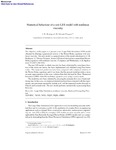Numerical Behaviour of a New LES Model with Nonlinear Viscosity

Use este enlace para citar
http://hdl.handle.net/2183/26938
Excepto si se señala otra cosa, la licencia del ítem se describe como Atribución-NoComercial-SinDerivadas 4.0
Colecciones
- Investigacion (ETSAC) [512]
Metadatos
Mostrar el registro completo del ítemTítulo
Numerical Behaviour of a New LES Model with Nonlinear ViscosityFecha
2020Cita bibliográfica
J.M. Rodríguez, R. Taboada-Vázquez, Numerical behaviour of a new LES model with nonlinear viscosity, Journal of Computational and Applied Mathematics. 377 (2020) 112868. https://doi.org/10.1016/j.cam.2020.112868
Resumen
[Abstract] The objective of this paper is to present a new Large Eddy Simulation (LES) model obtained by filtering a generalized version of the Navier–Stokes equations with nonlinear viscosity. This new model is a generalization of the model introduced in Rodríguez and Taboada-Vázquez (2017). The new LES model, in which viscosity has been substituted by a nonlinear function of the strain rate tensor, has been implemented and validated using FreeFem++ codes. The numerical predictions have been compared with analytical solutions of the Navier–Stokes equations and it was found that the present model provides a more accurate approximation of the exact solution than that obtained by Direct Numerical Simulation (DNS) of the Navier–Stokes equations, even using a coarser mesh. The model has also been validated by studying the unsteady flow over a backward-facing step. In this case, our numerical predictions have been compared with the experimental measurements reported by Armaly et al. (1983) and the numerical results obtained by Chacón and Lewandowski (2014). The new model performs satisfactorily in predicting these flows too.
Palabras clave
Large Eddy Simulation
Nonlinear viscosity
Backward Facing Step Flow test
Nonlinear viscosity
Backward Facing Step Flow test
Descripción
Preprint submitted to Elsevier
Versión del editor
Derechos
Atribución-NoComercial-SinDerivadas 4.0






